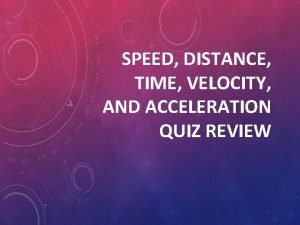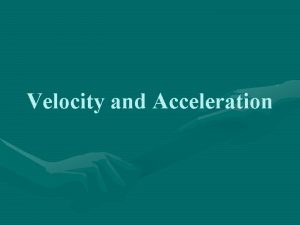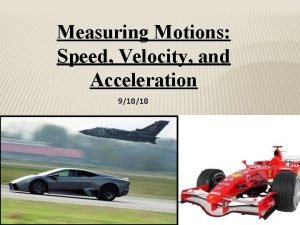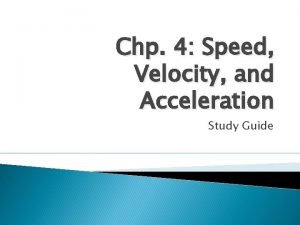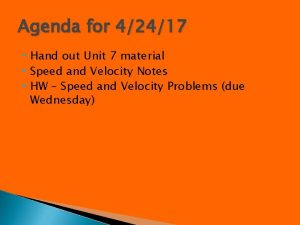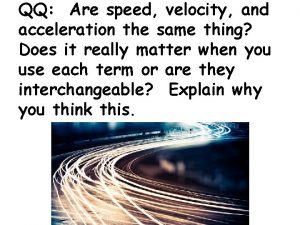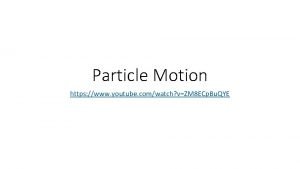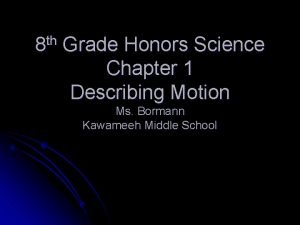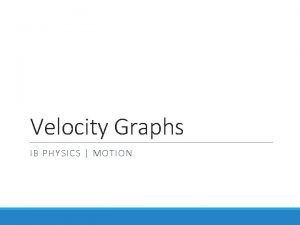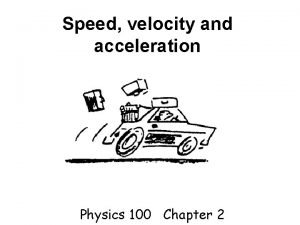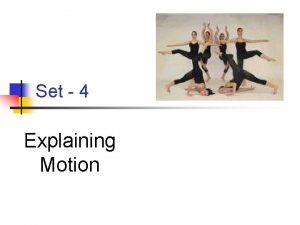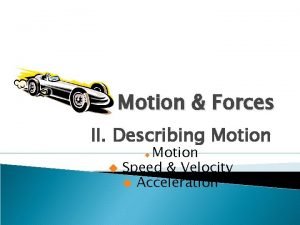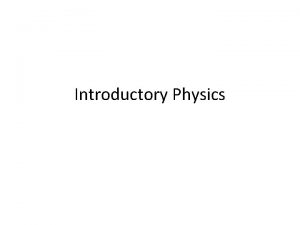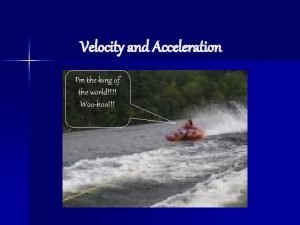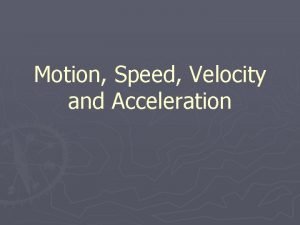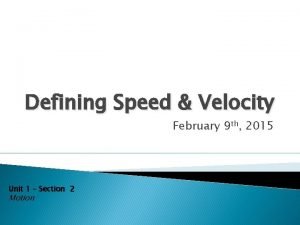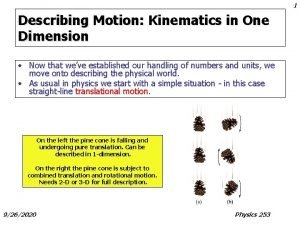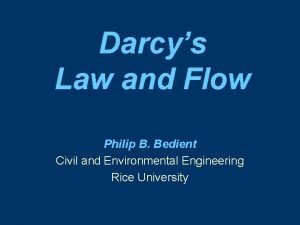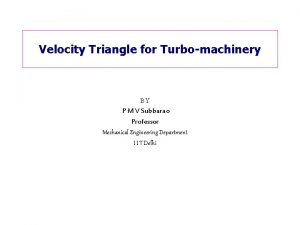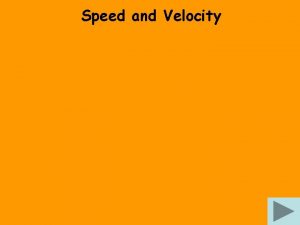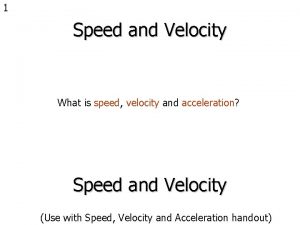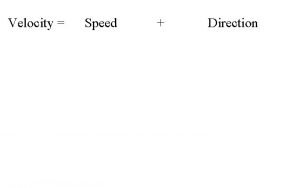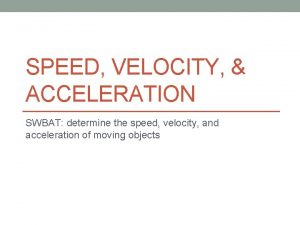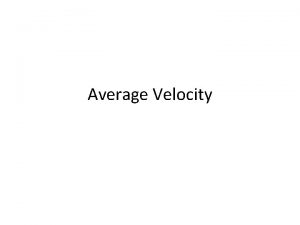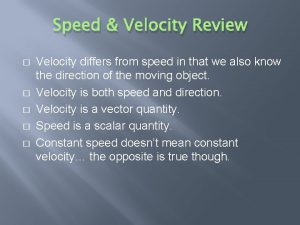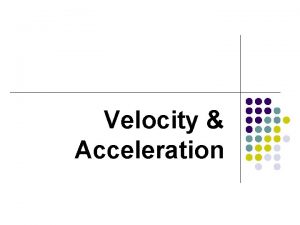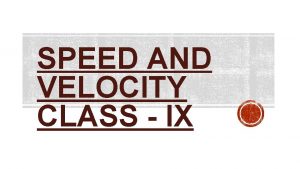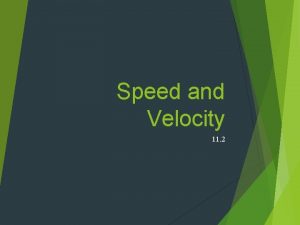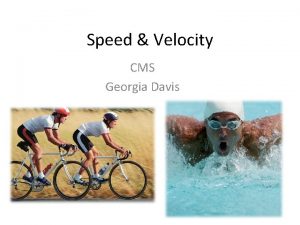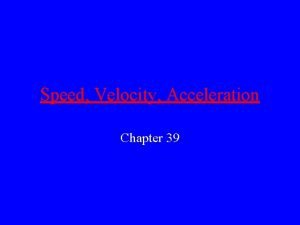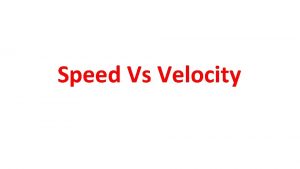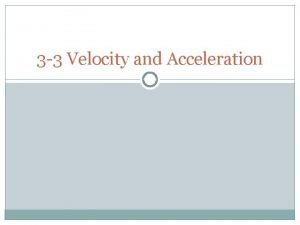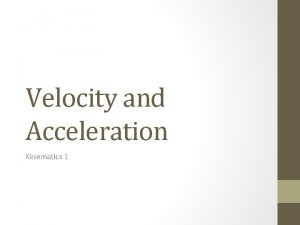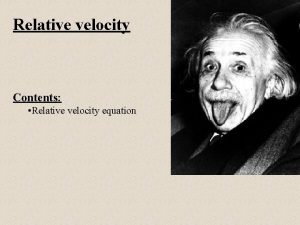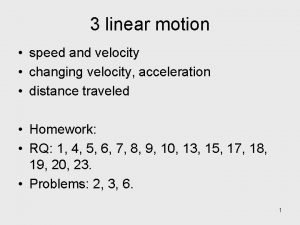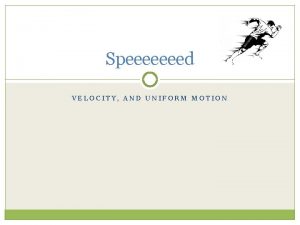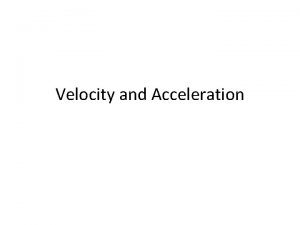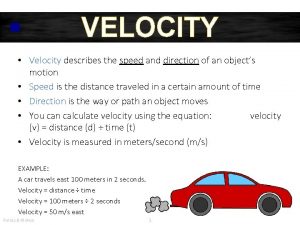1 Speed and Velocity What is speed velocity

































- Slides: 33

1 Speed and Velocity What is speed, velocity and acceleration? How does speed, velocity and acceleration relate to Forces & Motion?

2 How does MOTION relate to POSITION and TIME? Description of MOTION often includes speed and is a change in position. SPEED then is the rate of change in position or the “rate of motion. ” QUESTION: Do you have to see something move to know that motion has taken place? ANSWER: No – because the only thing needed is a reference point to see that something has changed position.

3 Measures of Speed Pretend you are looking at your car's speedometer while you are driving. The reading you get from your speedometer is… instantaneous speed. This is the speed that you are traveling at that moment.

4 Now, let’s say you are on a highway, a car may travel at the same speed for a long period of time this would be… constant speed. This is the speed that does not vary – cruise control.

5 Now, let’s say that you are trying to determine the distance you are going to traveled in a given amount of time by the time – this would be… Katy Houston - - - average speed. Speed is the distance traveled per unit of time.

6 Calculating Speed Distance, Speed and Time is shown in the equation: speed = distance time . . . or shortened: d s= t s = Speed d = Distance t = Time

7 Manipulating the Equation d The equation reads - s = t but it can be rearranged to solve for any variable. divide So, to find DISTANCE, we need to MULTIPLY speed and time. d=sxt D meters S m/s T seconds multiply And, to find TIME, we need to DIVIDE distance by the speed. d t= s

8 Four Step Approach to Solving Problems Step 1 Read the problem. Draw a picture. Step 2 Write down what you know. What are you trying to find? Step 3 Set up the formula. Step 4 Substitute the numbers. Solve. Box Answer with UNITS!

9 Consider the problem… “A car traveled 110 miles in 2 hours. ” Step 1 Read the problem. Draw a picture. 110 miles 2 hours d= t= s= Formula Substitute Units, units! Answer

10 “A car traveled 110 miles in 2 hours. ” Step 2 Write down what you know. What are you trying to find? 110 miles 2 hours d = 110 miles t = 2 hours s= Formula Substitute Units, units! Answer

11 “A car traveled 110 miles in 2 hours. ” Step 3 Set up the formula. s= d = 110 miles t = 2 hours s= Formula s= d t Substitute d t Units, units! Answer

12 “A car traveled 110 miles in 2 hours. ” Step 4 Substitute the numbers. Solve. Box Answer with Units. 110 miles 2 hours Formula d = 110 mi t = 2 hours s = 55 mi/hr S= d t Substitute Answer S = 110 mi 2 hr S = 55 mi/hr Units, units!

13 Do the problems 1 -3 on your notes.

14 Consider the problem… “A runner’s average speed during the 10 kilometer race was 20 km/hr. What was his time? ’” Step 1 Speed of runner: 20 km/hr d= t= s= Read the problem. Draw a picture. 10 km Formula Substitute Units, units! Answer

15 “A runner’s average speed during the 10 kilometer race was 20 km/hr. What was his time? ’” Step 2 Write down what you know. What are you trying to find? Speed of runner: 20 km/hr d = 10 km Formula Substitute t= s = 20 km/hr Units, units! Answer

16 “A runner’s average speed during the 10 kilometer race was 20 km/hr. What was his time? ’” Step 3 Set up the formula. Speed of runner: 20 km/hr 10 km d = 10 km Formula t= s = 20 km/hr t= d s Substitute Units, units! Answer

17 “A runner’s average speed during the 10 kilometer race was 20 km/hr. What was his time? ’” Step 4 d = 10 km t = 0. 5 hr s = 20 km/hr Substitute the numbers. Solve. Box Answer with Units. Formula Substitute t=d s 10 km t= Answer 0. 5 hr 20 km/hr If the runner’s average speed was 20 km/hr during the 10 km race, the runner’s time was 0. 5 hours. Units, units!

18 Do the problems 4 -5 on your notes.

19 “You decide to go to Dallas to visit your friends. Your friends tell you that it takes 4 hours to get to Dallas at an average speed of 70 miles per hour. Approximately how many miles is it to their house? ” Step 1 Step 2 Read the problem. Draw a picture. Write down what you know. What are you trying to find? d = 280 mi Formula t = 4 hr s = 70 mi/hr d=sxt ? Step 3 Set up the formula. Step 4 Substitute the numbers. Solve. Box Answer with units. Substitute d = 70 mi/hr x 4 hr Answer d = 280 miles Units, units! If I drive 4 hours at 40 mph, the distance from Houston to Dallas is 280 miles.

20 Do problem 6 on your notes.

21 A distance/time graph makes it possible to “see” speed. This graph shows how fast the swimmers went during their workout. d e e Which swimmer swam at a constant (the same) speed throughout her workout? p s t n a t s n Which one stopped during his/her workout? Co Is a g ai in tl e h r st Stopped here 400 meters at 10, 15, & 20 minutes

22 Make the speed graph in your notes & answer the questions.

23 Instantaneous speed (Reading on your speedometer) and average speed does not involve direction. So, what would involve both speed and direction……. . VELOCITY.

24 What is the difference between speed and velocity? r m 5 5 i/h Velocity has speed & direction. All of these cars had the same SPEED but, 55 mi/hr different VELOCITIES because they were traveling in different directions. If you change direction, you have changed your velocity – and if you have changed your speed, you have changed your velocity. Therefore, any 5 5 m change in speed OR direction is a i/h r change in velocity!

25 Why is it important to know the VELOCITY of a tornado?

26 Acceleration Here we are back at the same questions…… What is speed, velocity and acceleration? How does speed, velocity and acceleration relate to Forces & Motion?

27 Acceleration … is defined as the change in velocity over time. (change) in velocity acceleration = time final velocity – initial velocity a= time Vf - V i t

28 Types of Acceleration • Positive Acceleration – Velocity and acceleration are in the same direction. – Object SPEEDS up. • Negative Acceleration –Velocity and acceleration are in opposite direction. –Object SLOWS down.

29 A go-cart started from the top of a hill at 5 meters per second. At the bottom of the hill it ended up with a speed of 35 meters per second 6 seconds later. What was the acceleration of the go-cart? Step 1 Vf = Formula Read the problem. Draw a picture. Substitute Answer In 6 s V i= t= a= 5 m/s top bottom 35 m/s

30 A go-cart started from the top of a hill at 5 meters per second. At the bottom of the hill it ended up with a speed of 35 meters per second 6 seconds later. What was the acceleration of the go-cart? Start: Step 2 Write down what you know. What are you trying to find? Vf = 35 m/s Vi= 5 m/s Formula Substitute Answer 6 s t= 6 s a= bottom 35 m/s Finish: final Velocity initial Velocity 5 m/s top

31 A go-cart started from the top of a hill at 5 meters per second. At the bottom of the hill it ended up with a speed of 35 meters per second 6 seconds later. What was the acceleration of the go-cart? Step 3 Initial Velocity Set up the formula. 5 m/s top Vf - V i t Vf = 35 m/s Formula Substitute Vi= 5 m/s Vf - V i t= 6 s a= Answer 6 s t bottom 35 m/s Final Velocity

32 A go-cart started from the top of a hill at 5 meters per second. At the bottom of the hill it ended up with a speed of 35 meters per second 6 seconds later. What was the acceleration of the go-cart? Step 4 Vf = 35 m/s Vi= 5 m/s t= 6 s Substitute the numbers. Solve. Box Answer with Units. Formula Substitute Vf - Vi 35 m/s – 5 m/s t 6 s Answer 30 m/s 6 s = 5 m/s 2 a = 5 m/s 2 The go-cart that traveled from 5 m/s to 35 m/s in 6 seconds had an acceleration of 5 m/s 2.

33 Do the problems 7 -9 on your notes.
 Linear and angular quantities
Linear and angular quantities Initial velocity and final velocity formula
Initial velocity and final velocity formula Site:slidetodoc.com
Site:slidetodoc.com Velocity=distance/time
Velocity=distance/time Speed velocity and acceleration problems
Speed velocity and acceleration problems Difference between speed and velocity class 9
Difference between speed and velocity class 9 Constant speed on distance time graph
Constant speed on distance time graph What is the difference between speed and velocity
What is the difference between speed and velocity Velocity describes both speed and
Velocity describes both speed and Acceleration
Acceleration Speed velocity and acceleration study guide answers
Speed velocity and acceleration study guide answers Speed and velocity
Speed and velocity Are speed and acceleration the same thing
Are speed and acceleration the same thing Youtube https //www.youtube.com/watch v=vnp84pn0mjq
Youtube https //www.youtube.com/watch v=vnp84pn0mjq Chapter 2 motion section 1 describing motion answer key
Chapter 2 motion section 1 describing motion answer key Speed, velocity and acceleration notes
Speed, velocity and acceleration notes Chapter 1 lesson 2 speed and velocity answer key
Chapter 1 lesson 2 speed and velocity answer key Distinguish between speed and velocity class 9
Distinguish between speed and velocity class 9 Velocity and acceleration
Velocity and acceleration Speed and velocity difference
Speed and velocity difference Difference between speed and velocity
Difference between speed and velocity How to describe motion in physics
How to describe motion in physics Velocity describes both speed and
Velocity describes both speed and Speed and velocity
Speed and velocity Speed and velocity
Speed and velocity Speed and velocity
Speed and velocity Darcy velocity units
Darcy velocity units Is v final velocity
Is v final velocity Instantaneous velocity vs average velocity
Instantaneous velocity vs average velocity Darcy law example
Darcy law example Tangential speed
Tangential speed Angular acceleration formula in terms of radius
Angular acceleration formula in terms of radius Find speed
Find speed Change in velocity triangle
Change in velocity triangle



